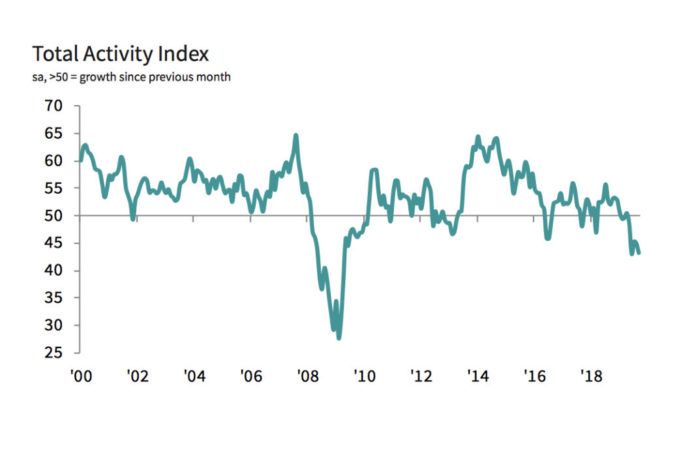The UK construction sector remained firmly stuck in a downturn at the end of the third quarter. Building activity fell at the second-fastest rate since April 2009, only narrowly outpaced by June’s decline. A historically steep drop in new orders was also registered, while rms trimmed employment at the fastest rate since the end of 2010 due to unfavourable demand, client hesitancy and low confidence. Although there was a marginal pick-up in optimism, the level signalled by survey data was still historically weak.
The headline seasonally adjusted IHS Markit/CIPS UK Construction Total Activity Index posted 43.3 in September, down from 45.0 recorded in August and thereby signalling a more severe downturn in building activity across the UK. Moreover, the deterioration was the second-strongest since April 2009 and broad-based across all three broad categories of construction work.
As has been the case since March, commercial activity was the worst-performing segment. Here, the contraction gathered pace and was marked overall. Meanwhile, civil engineering activity dropped at a similarly sharp rate that was the fastest in close to a decade. A fourth successive monthly decrease in residential building was also signalled.
Latest survey data highlighted further demand weakness in the UK construction sector. Having fallen at the steepest rate since March 2009 last month, there was little sign of any recovery in September as new work inflows dropped at similarly substantial pace. Panellists attributed the marked slowdown to Brexit uncertainty and the resulting hesitancy caused among clients, as well as a general underlying weakness in demand.
The strong dip in sales coincided with a further tapering of purchasing activity by UK construction companies in September. Buying levels declined at the joint-fastest rate since January 2010 due to lower operational requirements and increased e orts to contain costs.
Nevertheless, input prices continued to rise at a strong rate during September. The rise in costs was partly linked to greater fuel expenses and higher supplier charges for certain raw materials. However, the rate of inflation eased to a three-and-a-half-year low in line with deteriorated input demand. Still, panellists reported bottlenecks and material shortages at suppliers, both of which contributed to further delivery delays.
Looking ahead, UK construction rms were mildly optimistic that output volumes would pick up over the coming 12 months, although the level of business confidence was weak by historical standards. Competitive pressures, Brexit uncertainty and concerns towards the economy led to a subdued year-ahead outlook.
In line with weak optimism, further cost-cutting e orts were apparent as employment was reduced in the UK construction sector during the latest survey period. The fall in staffing levels was the sixth in as many months and the strongest since the end of 2010.
Joe Hayes, economist at IHS Markit, which compiles the survey, said: “The UK construction sector remained mired in a downturn at the end of the third quarter, according to the latest PMI data. Activity is being pulled down at its second-fastest clip for over a decade as firms are buffeted by client hesitancy, heightened Brexit uncertainty and a weak outlook for the UK economy. The commercial sector was a notable casualty in September, with building activity here falling at the fastest rate since April 2009, highlighting the damaging effects of project delays and belt-tightening.
“Low confidence has subsequently caused construction order books to fall substantially. Panellists reported another sharp drop in demand in September that was one of the strongest in the post-crisis era. Forward- looking indicators suggest that businesses are bracing themselves for a protracted construction slump, with input purchasing and employment both falling at rates unsurpassed since 2010.
“Overall, the performance of the UK economy once again hinges on the service sector showing a marked degree of resilience to offset the weakness seen in construction and manufacturing.”
Duncan Brock, group director at the Chartered Institute of Procurement & Supply, said: “The construction sector offered another devastating result in September with the second fastest fall in new orders since March 2009 and the financial crisis. After a relentless six-month decline in order books driven by Brexit uncertainty and political indecision, this is hardly surprising.
“Residential building continued to be hit hard with a fourth successive month of deterioration but the commercial sector took the biggest brunt of this downturn spiral as clients turned their back on spending and committing to larger projects. This in turn had significant knock-on effects on construction employment with the biggest fall in staffing levels since December 2010. Such disappointing news as the sector is still recovering from a lack of skills and capacity created by the last recession.
“Looking ahead the signs do not look positive. Even a moderation in input prices since March 2019 and some moderate improvement in supply chain pressures will not be enough to keep the wolf from the door as no-deal looms and businesses remain Brexit unsteady.”




